On the second day of our Parma Culinary Tour we headed off at first light to Bologna to the Felsineo factory to see their production of Mortadella.
Now this was a very large factory with several hundred employees and a large export market in America, where Mortadella is known as Balony( after the adjacent city of Bologna.)
The Mortadella was made in the traditional way,
some even in the traditional casing and stringing
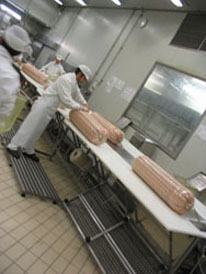

But the great majority of it was vac-packed in smaller sausages.
They afterwards fed us a lunch of Mortadella (and much wine)
Again showing how impressive Italian hospitality could be.
But at the end of the day the stuff tasted just too much like
our own “Luncheon Meat” to be really exciting.
Our next visit couldn’t have been more different.
We went to the outskirts of Modena to meet young Mariangela Montanari in
“La Ca del Non” (literally Granddad’s Place) and see her production of Balsamic Vinegar.
Mariangela is, according to her mother, obsessed with Vinegar.
The first lesson we had to learn was that this product, Aceto Balsamico Tradizionale di Modena, had absolutely nothing to do with that product –“made from fermented grapes, caramel and sugar” she spat- which goes by the name of Balsamic vinegar in our supermarkets.
True Balsamic Vinegar is made from the unfermented must of grapes

In their case from their own Trebbiano vine, growing outside.
which is reduced by long cooking, naturally
acidified by using a vinegar “mother”
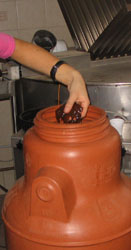
Mariangela shows us a vinegar mother
(a liver like jellied lump) in one of
her acidification churns.
Before the advent of Stainless Steel
most of the acidification used to take
place in wonderful green glass bottles.
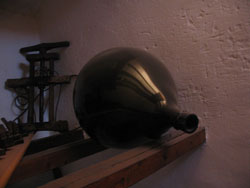
And then nothing added except time.
It is then very slowly aged in successions of
smaller barrels all made of different aromatic
woods until the first “young” product is passed
by the consortium after 12 years.
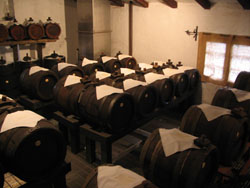
The various casks aging gently in the attic of Ca del Non.
Then it is entitled to be known as Balsamic Vinegar Tradizionale di Modena.
It can be kept in barrels for longer periods of time where it continues to mature and change with age.
But the proof of the pudding was certainly in the tasting.
We were given little plastic teaspoons and permitted to taste just three drops of various vintages of the vinegars.
They were marvellous.
Great mouth filling taste explosions of sweetness acidity and subtle woodiness.
I think we all bought at least one bottle to take away.
These purchases are more surprising than you think
(specially from a bunch of hard nosed Irish restaurateurs)
as the bottles were 100ml (about 3 fluid ounces)and cost
anything from €47 to €120.
I intend to have some of mine left for my hundredth birthday party.
The rest of that day was spent in Massimos
I have already told you about the magic visit there.
But our third and last day in Italy still had some treats in store for us.
Our last day was another early riser and involved us all in the only truly uncivilized aspect of Italy we noticed on this holiday.
The otherwise perfectly acceptable breakfast in our hotel was spoiled by having coffee and tea available only from a machine, inevitably with a queue of about 10 people in front of it.
On that particular morning a Japanese Lady decided to get the coffee for her entire table just before me.
Anyone who knows me well will understand how close she came to death by coming between me and my first cup of coffee.
Our only trip before lunch and our flight home was to a Parmesan cheese maker.
The huge cheese making facility that was La Speranza contained just a small (4 worker) family business.
The making of Parmigianno Reggiano is an extremely simple process and , like the manufacture of the hams and the vinegars most of the complexities of flavour and texture are provided by nature and old father time.
First the morning milk is stored overnight in large stainless containers, in the morning the cream is skimmed off to make butter, then the previous evenings full milk is mixed with this skimmed milk and some of the whey from the previous day’s cheese making and some rennet.
This mixture is then heated in large copper vats, the curd broken with knives and left to settle. After one hour the now solid curd is drained off in a muslin cloth and each of these lumps of solid curd is then cut in two to produce the large traditional blocks of Parmesan.
Most of the whey then goes on to feed the pigs that in their own turn provide us with Parma Ham.
Neat isn’t it?
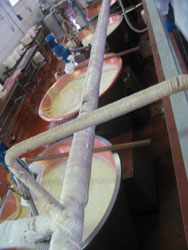
Curds and Whey “cook” and seperate
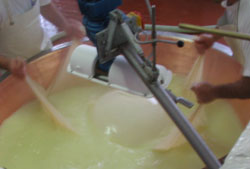
The ball of solid curd is lifted out to drain
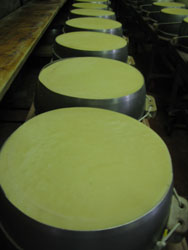
The cheeses drain in stainless moulds prior to brining
The cheeses are soaked in brine (salt being their only additive other than time)
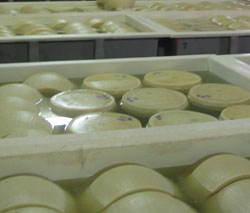
and then aged for at least one year before
being tested by yet another consortium and
then being entitled to call themselves
Parmigiano Reggiano.
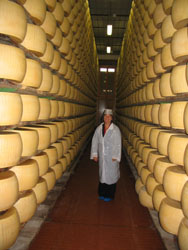
Sile among the Aging Parmesans
Another little thing they told us explains something I have long wondered about.
If a cheese is reckoned to be off and failed by the consortium it is then sold on the a factory who grate it and and sell this as grated Parmesan.
This explains the foul smell of that particular product!
We all managed to both eat and buy great chunks of Parmigiano
in La Speranza before heading off on the last visit of the journey.
This was to Gualtiero Marchesi’s own restaurant in Ebrusco.
He had done a special menu for us Irish Euro-Toques
I will quote it here in full:
Salad of Raw Seabass and Spinach with Mustardseed Sauce
Risotto with Red Beetroot juice,
Franciacorta wine and Parmesan Sauce

Fillet of Veal Orloff with a Potato Pie
Strawberries with Yoghurt Icecream
Hot Vanilla cake with Vanilla Sauce.
It was just as good as it sounds.
We were obviously given a special room with a huge mural of chefs on one wall.
As soon as the meal started the mural disappeared into the ceiling leaving the spotless and smooth running kitchen exposed behind a sheet of glass.

Highly theatrical!
We all of course accepted this as if in the manner born.
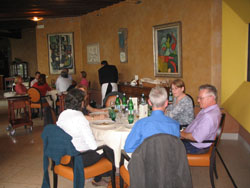

And afterwards spent some time strolling through
Marchesi’s modern sculptures in his gardens.
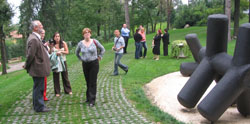
Where even the rabbits came to offer themselves to his kitchen.

And then that was it.
Back to the bus, back to the airport and home.
A wonderful trip
Well done (again) to Ruth and Abigail for the organisation.
Last word
When we got home our sunflower had come completely out.
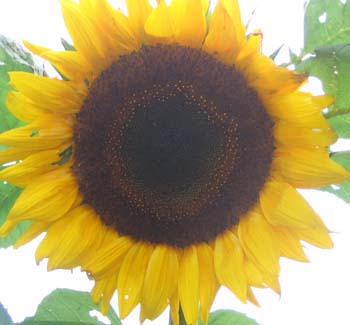
Life goes on!

Comments
Dermot
on September 27, 2005God Martin, that sounds like an awful trip. Retirement must really be a pain.
Hope you’re all well.
dermot
Martin
on September 27, 2005Thank You Dear Dermot, No-one appreciates the suffering I undergo silently since my retirement.
The comments are closed.